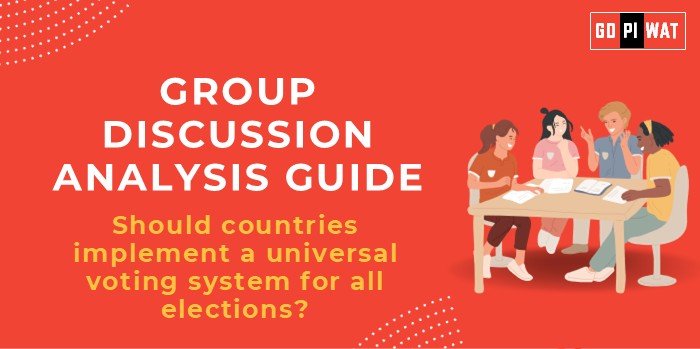📋 Group Discussion Analysis Guide
🌍 Topic: Should Countries Implement a Universal Voting System for All Elections?
🌐 Introduction to the Topic
Universal voting systems are increasingly debated as nations address issues like voter accessibility, fraud prevention, and technological advancements. A universal voting system standardizes voting processes, technology, and rules across all elections in a country, addressing inconsistencies in electoral administration and strengthening democratic participation.
📊 Quick Facts and Key Statistics
- Global Voting Turnout Decline: 66% in 2020 (worldwide average) vs. 70% in 2000, highlighting the need for reform.
- Cost of Elections: U.S. 2020 elections cost $14 billion, showcasing financial challenges of decentralized systems.
- Estonia’s E-Voting Success: 46.7% of voters used online platforms in 2023, demonstrating the efficiency of universal systems.
- Accessibility Issues: 25% of eligible voters worldwide face obstacles like geographic remoteness or physical disabilities.
🎭 Stakeholders and Their Roles
- Governments: Policy formulation and implementation.
- Election Commissions: Administration and enforcement of uniform rules.
- Technology Providers: Development of secure digital infrastructure.
- Citizens: Active participation and feedback.
- International Organizations: Providing technical support and sharing best practices.
🏆 Achievements and Challenges
✨ Achievements
- Enhanced Accessibility: E-voting in Estonia expanded reach to remote voters.
- Cost Savings: Uniform systems reduce administrative overhead.
- Increased Trust: Standardized rules improve transparency.
⚠️ Challenges
- Cybersecurity Risks: High-profile breaches like the 2020 U.S. election hacking attempts.
- Resistance to Change: Political and institutional inertia.
- Inequality of Access: Digital divides in rural vs. urban areas.
🌍 Global Comparisons
- Estonia: Leads with digital systems; increases voter turnout among expatriates.
- United States: Decentralized model highlights pitfalls like inconsistent ballot designs.
📖 Structured Arguments for Discussion
- Supporting Stance: “A universal voting system ensures consistency, reduces errors, and enhances public trust.”
- Opposing Stance: “Standardization may overlook local nuances and could exacerbate access inequalities.”
- Balanced Perspective: “While standardization offers efficiency, it requires safeguards for inclusivity and cultural adaptation.”
💡 Effective Discussion Approaches
- Opening Approaches:
- Highlight global trends in voter turnout and system inefficiencies.
- Use a success story like Estonia’s e-voting model.
- Counter-Argument Handling:
- “Centralized systems may be prone to hacking; however, advanced cryptographic solutions mitigate such risks.”
📊 Strategic Analysis (SWOT)
- Strengths: Standardization, cost-effectiveness, improved voter trust.
- Weaknesses: Implementation costs, cybersecurity risks.
- Opportunities: Technological advancements, global partnerships.
- Threats: Political opposition, digital exclusion.
📚 Connecting with B-School Applications
- Real-World Applications: Analyze voting systems in operations management or policymaking projects.
- Sample Interview Questions:
- “What role does technology play in ensuring free and fair elections?”
- “How can universal systems balance standardization with inclusivity?”
- Insights for Students:
- Study public policy frameworks for tech-based governance.
- Explore cybersecurity’s role in e-governance.


